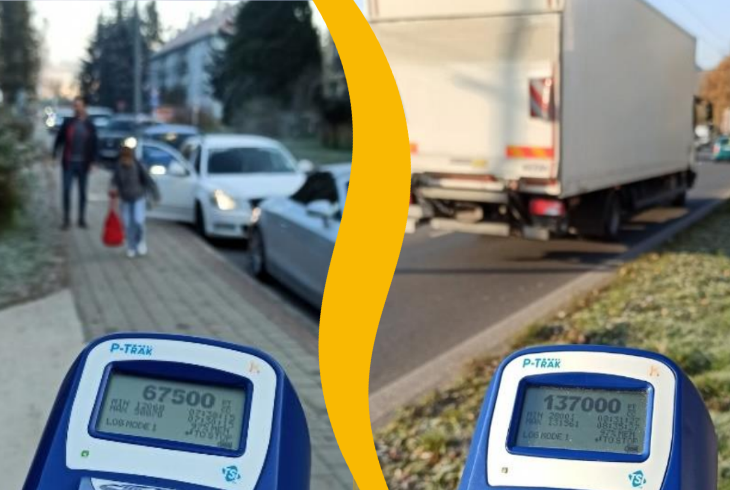

New
Measurement of ultrafine particles shows how sensitive the air is to changes. How can we influence these changes?
21. 02. 2025
![]() Mobility
Mobility
From 7 to 12 November 2024, an informative measurement of air pollution by ultrafine particles (UFP – from the English “ultrafine particle”) was carried out in Sereď, Banská Bystrica, Čertovica, and Prešov. The aim of the measurements was to determine the extent to which road traffic affects UFP pollution in inhabited areas of Slovakia. Traffic-related pollution measurements were conducted as part of the Populair project in cooperation with the non-governmental organization CEPTA.

Ultrafine particles are particles with a diameter less than or equal to 100 nm (0.1 µm), which can easily penetrate from the respiratory system into the bloodstream and reach sensitive organs or the central nervous system. Their presence in the blood can affect its functions and properties. They are highly reactive and may contain heavy metals and toxic substances. The mass of UFP is negligible within the standard size spectrum of PM10 and PM2.5, so for assessing health impacts, it is more appropriate to measure particle count and size distribution.
Compared to PM10 and PM2.5, which are regulated and have clearly defined measurement standards, UFP are currently not included in Slovak national legislation regulating air quality. In the new EU Directive on Ambient Air Quality and Cleaner Air in Europe from October 2024, UFP are listed as a new pollutant that will be mandatory to monitor. Due to the size and population of member states, requirements for the placement of sampling sites for UFP measurement vary.
CEPTA measurements were conducted using a P-Trak Ultrafine Particle Counter by TSI, model 8525, which measures UFP with a diameter of 0.02–1 µm as particle count per cm³ of air. The results clearly confirmed the relationship between UFP count and traffic intensity.
Parent taxi
November measurements showed that increased personal vehicle traffic leads to higher UFP levels in the air. In Sereď and Banská Bystrica, measurements were conducted at two different times around schools, where morning traffic is intensified due to so-called “parent taxis,” which was confirmed by UFP measurement results. Conversely, in the evening, when traffic density around schools was lower, UFP concentrations were up to 50% lower. Walking, cycling, scootering, or using public transport for school commutes would improve both air quality and children’s safety.
Busy roads
Measurements at Čertovica pass, along the busy first-class road I/72, highlighted how quickly air quality can change. When a convoy of cars passed, pollution increased sharply, and during traffic-free periods, values decreased significantly.
In Prešov, measurements were carried out at busy intersections and low-traffic areas. As expected, traffic pollution directly at intersections was significantly higher than in the city center (pedestrian zone) or on a meadow above the city (urban background).
In Banská Bystrica, contrasting measurements were taken at a busy intersection, along a busy road, at a bus stop, in the central pedestrian zone, and at the city outskirts. Differences were observed between morning and evening measurements, where evening UFP spikes in the pedestrian zone were likely influenced by nearby gastronomy establishments.
Emissions from personal vehicles in ambient and indoor air
The measurement team also examined vehicle types. Measurements near exhausts showed that older diesel vehicles (Euro 4 and earlier) are significant sources of UFP compared to gasoline and LPG vehicles, emitting concentrations above 500,000 UFP/cm³ (upper detection limit of the instrument). New diesel vehicles with functional DPF filters meeting Euro 6 standards emit almost no UFP, highlighting the importance of having functional particle filters.
For conventional vehicles, including electric cars, non-exhaust emissions from brake and tire wear or resuspended road dust must also be considered.
Inside vehicles, if the ambient air is polluted, occupants are exposed to high UFP concentrations if ventilation is on and outside air is drawn in. UFP are too small to be captured by standard pollen or dust filters in car ventilation systems.
Air quality assessment
The air we breathe is influenced by emissions from industry, traffic, households, and other natural sources, as well as dispersion conditions affected by weather or topography. Sampling devices in the national air quality monitoring network, operated by the Slovak Hydrometeorological Institute (SHMÚ), are installed 1.5–4 meters above ground (breathing zone) according to Air Quality Regulation No. 250/2023. Pollutants have limit or target values to protect human health, and some have a defined number of allowed exceedances. SHMÚ evaluates air quality through continuous measurements, calculations (modeling), forecasting, or estimation. Annual air quality reports are published.
CEPTA’s role
The Center for Sustainable Alternatives (CEPTA), established in 2005, supports activities promoting sustainability. As part of the LIFE IP – Air Quality Improvement project, CEPTA measures ultrafine particles to raise public awareness of air pollution’s negative health effects and to present measures for reducing pollution.
The full report on UFP pollution from traffic is available here:
CEPTA – 250130 Transport UFP Report











